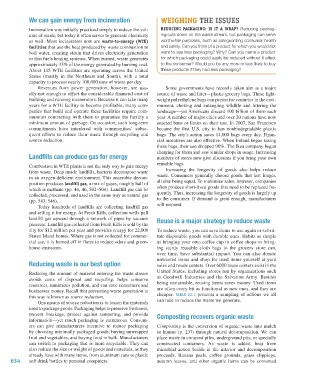Page 635 - Environment: The Science Behind the Stories
P. 635
We can gain energy from incineration WEIGHING THE ISSUES
Incineration was initially practiced simply to reduce the vol- REDUCING PACKAGING: IS IT A WRAP? Reducing packag-
ume of waste, but today it often serves to generate electricity ing cuts down on the waste stream, but packaging can serve
as well. Most incinerators now are waste-to-energy (WTE) worthwhile purposes, such as safeguarding consumer health
facilities that use the heat produced by waste combustion to and safety. Can you think of a product for which you would not
boil water, creating steam that drives electricity generation want to see less packaging? Why? Can you name a product
or that fuels heating systems. When burned, waste generates for which packaging could easily be reduced without ill effect
approximately 35% of the energy generated by burning coal. to the consumer? Would you be any more or less likely to buy
About 115 WTE facilities are operating across the United these products if they had less packaging?
States (mostly in the Northeast and South), with a total
capacity to process nearly 100,000 tons of waste per day.
Revenues from power generation, however, are usu- Some governments have recently taken aim at a major
ally not enough to offset the considerable financial cost of source of waste and litter—plastic grocery bags. These light-
building and running incinerators. Because it can take many weight polyethylene bags can persist for centuries in the envi-
years for a WTE facility to become profitable, many com- ronment, choking and entangling wildlife and littering the
panies that build and operate these facilities require com- landscape—yet Americans discard 100 billion of them each
munities contracting with them to guarantee the facility a year. A number of major cities and over 20 nations have now
minimum amount of garbage. On occasion, such long-term enacted bans or limits on their use. In 2007, San Francisco
commitments have interfered with communities’ subse- became the first U.S. city to ban nonbiodegradable plastic
quent efforts to reduce their waste through recycling and bags. The city’s action saves 14,000 bags every day. Finan-
source reduction. cial incentives are also effective. When Ireland began taxing
these bags, their use dropped 90%. The Ikea company began
charging for them and saw similar drops in usage. Increasing
Landfills can produce gas for energy numbers of stores now give discounts if you bring your own
reusable bags.
Combustion in WTE plants is not the only way to gain energy
from waste. Deep inside landfills, bacteria decompose waste Increasing the longevity of goods also helps reduce
in an oxygen-deficient environment. This anaerobic decom- waste. Consumers generally choose goods that last longer,
position produces landfill gas, a mix of gases, roughly half of all else being equal. To maximize sales, however, companies
which is methane (pp. 44, 46, 502–504). Landfill gas can be often produce short-lived goods that need to be replaced fre-
collected, processed, and used in the same way as natural gas quently. Thus, increasing the longevity of goods is largely up
(pp. 543, 546). to the consumer. If demand is great enough, manufacturers
Today hundreds of landfills are collecting landfill gas will respond.
and selling it for energy. At Fresh Kills, collection wells pull
landfill gas upward through a network of pipes by vacuum Reuse is a major strategy to reduce waste
pressure. Landfill gas collected from Fresh Kills is sold by the
city for $12 million per year and provides energy for 22,000 To reduce waste, you can save items to use again or substi-
Staten Island homes. Where gas is not collected for commer- tute disposable goods with durable ones. Habits as simple
cial use, it is burned off in flares to reduce odors and green- as bringing your own coffee cup to coffee shops or bring-
house emissions. ing sturdy reusable cloth bags to the grocery store can,
over time, have substantial impact. You can also donate
unwanted items and shop for used items yourself at yard
Reducing waste is our best option sales and resale centers. Over 6000 reuse centers exist in the
United States, including stores run by organizations such
Reducing the amount of material entering the waste stream
avoids costs of disposal and recycling, helps conserve as Goodwill Industries and the Salvation Army. Besides
resources, minimizes pollution, and can save consumers and being sustainable, reusing items saves money. Used items
businesses money. Recall that preventing waste generation in are often every bit as functional as new ones, and they are
this way is known as source reduction. cheaper. TABLE 22.1 presents a sampling of actions we all
One means of source reduction is to lessen the materials can take to reduce the waste we generate.
used to package goods. Packaging helps to preserve freshness,
prevent breakage, protect against tampering, and provide Composting recovers organic waste
information—yet much packaging is extraneous. Consum-
ers can give manufacturers incentive to reduce packaging Composting is the conversion of organic waste into mulch
by choosing minimally packaged goods, buying unwrapped or humus (p. 237) through natural decomposition. We can
fruit and vegetables, and buying food in bulk. Manufacturers place waste in compost piles, underground pits, or specially
can switch to packaging that is more recyclable. They can constructed containers. As waste is added, heat from
also reduce the size or weight of goods and materials, as they microbial action builds in the interior and decomposition
already have with many items, from aluminum cans to plastic proceeds. Banana peels, coffee grounds, grass clippings,
634 soft drink bottles to personal computers. autumn leaves, and other organic items can be converted
M22_WITH7428_05_SE_C22.indd 634 13/12/14 2:25 PM

